The Economics and Statistics Division maintains archives of previous publications for accountability purposes, but makes no updates to keep these documents current with the latest data revisions from Statistics Canada. As a result, information in older documents may not be accurate. Please exercise caution when referring to older documents. For the latest information and historical data, please contact the individual listed to the right.
<--- Return to Archive
For additional information relating to this article, please contact:
May 01, 2019PROVINCIAL GDP BY INDUSTRY 2018 The preliminary estimates of economic growth for the provinces and territories in 2018 were released today by Statistics Canada. Real GDP growth is measured at the industry level with chained 2012 dollars at basic prices (sellers' prices before taxes less subsidies on products) that removes the effect of price changes.
The GDP estimates for 1997-2017 have been revised to includes economic activities associated with licensed and unlicensed cannabis production, distribution and consumption for medical and non-medical use.
In 2018, Nova Scotia real GDP grew 1.2 per cent, the fifth consecutive year of growth. Real GDP growth slowed for the pace of 1.5 per cent that occurred the previous two years. The goods-producing sector expanded by 1.0 per cent while the service-producing industries grew by 1.3 per cent.
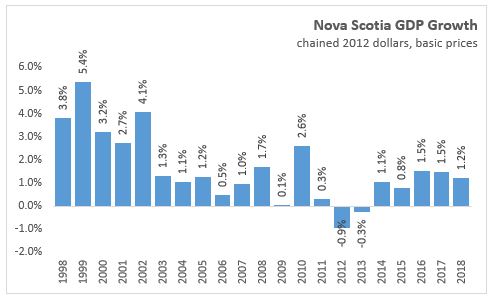
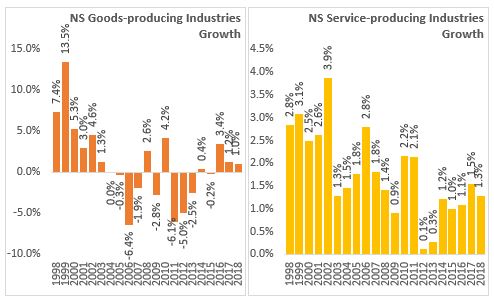
The goods-producing sector grew 1.0 per cent. Agriculture, forestry, fishing and hunting was up 1.0 per cent with higher output in forestry and logging (+4.3%), animal production (+7.4%), cannabis production (+12.1%), aquaculture (+3.3%) offsetting a decline in crop production (except cannabis) of 10.7 per cent. Fishing, hunting and trapping activity was mostly unchanged with a 0.1 per cent increase in real GDP.
Mining, quarrying and oil and gas extraction expanded 25.8 per cent with the first full year of production at Touquoy gold mine and increases in support activities within the sector. Oil and gas extraction fell 42.7 per cent with final production at Deep Panuke and Sable in 2018. Utilities real GDP was up 3.9 per cent on higher electric power generation, transmission and distribution.
Construction real GDP fell 6.1 per cent with decreases in non-residential building construction (-3.5%) and engineering construction (-29.3%) offsetting a strong increase in residential building construction (+9.7%). Completion of major projects including Maritime Link and gold mine infrastructure were important factors in construction sector decline.
Manufacturing real GDP was up 3.9 per cent, the fourth consecutive year of growth, with notable gains in rubber product manufacturing (+15.6%), pharmaceutical and medicine (+15.3%), paper manufacturing(+13.7%) , and machinery (+14.6%) and declines in seafood product (-13.7%) and wood product (-9.4%).
Service-producing industries GDP grew by 1.3 per cent in 2018. Wholesale (+1.0%) and retail trade (+0.2%) had significantly slower growth in 2018 than 2017 with declines in motor vehicle and parts wholesale and retail.
Transportation and warehousing real GDP was up 1.1 per cent on growth or no change across subsectors except pipeline transportation.
Information and cultural industries (-1.5%) declined for the third consecutive year. There was a decrease of 17.9 per cent among newspaper, periodical, book and dictionary publishers as some newspapers moved from daily to weekly publication schedules.
Finance and insurance rose 1.0 per cent in 2018 after declining 0.1 per cent in 2017. Depository credit intermediation (+0.7%) grew after declining the previous year while non-depository credit intermediation (-4.6%) declined after growing the previous 3 years. Insurance carriers real GDP declined 0.7 per cent following three years of growth.
Real estate and rental and leasing real GDP growth slowed to 1.4 per cent in 2018 with growth in owner-occupied imputed rent (+2.3%), offices of real estate agents/brokers (+3.2%) offset declines in lessors of real estate (-1.3%) and rental and leasing service s(-4.1%).
Professional, scientific and technical services grew 2.0 per cent in 2018 after a slower gain of 0.8 per cent gain in 2017. Growth among the subsectors of accounting (+5.6%), computer systems design (+4.5%), and scientific research an development service s( 9.3%) offset declines seen in legal services (-6.6%), specialized design services (-2.5%), and advertising services (-9.3%).
Administrative and support services real GDP grew by 3.2 per cent after 3 years of decline. There was higher output in office administrative, business, security and building support services.
Accommodation services (+3.9%), food services (+0.5%), arts, entertainment and recreation (+1.8%), and other services (except public administration) (+2.9%) were all up in 2018.
The public sector (education, health care and public administration) grew 1.6 per cent in 2018. Education services grew 1.4 per cent on higher output of elementary and secondary schools (+2.7%). Health care and social assistance grew 2.2 per cent in 2018 after growth of 1.9 per cent in 2017 with increases in all subsectors. Public administration (+1.0%) was up with increases in defense service (+0.9%), federal public administration (+1.2%), provincial public administration (+0.7%) and local, municipal, regional and aboriginal public administration (+2.2%).
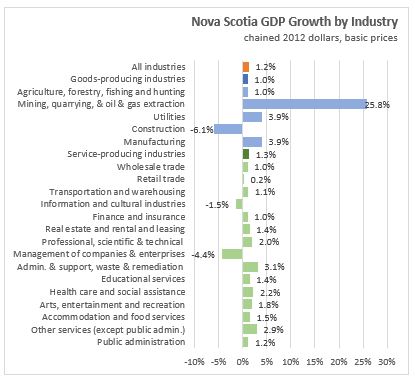
All provinces, except Newfoundland and Labrador, reported positive economic growth in 2018. Nationally, real GDP grew by 2.0 per cent. The fastest growth occurred in Prince Edward Island (+2.6%), followed by Quebec (+2.5%) and British Columbia (+2.4%).
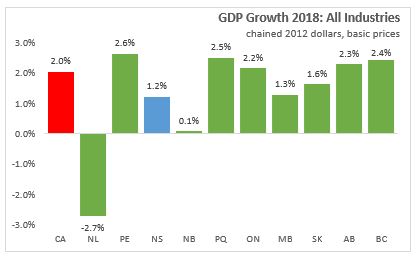
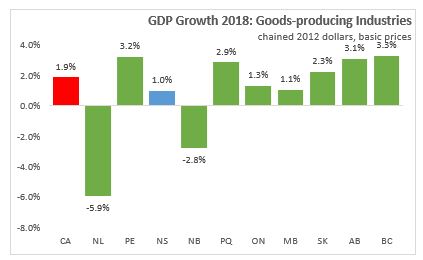

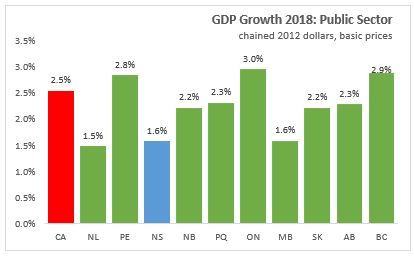
The revisions to GDP by industry with the inclusion of the cannabis sector does not have a significant impact on the level or growth rate of real GDP over 1997 to 2018. The Nova Scotia economy, excluding the cannabis sector, grew 39.2 per cent from 1997 to 2018. The inclusion of the cannabis sector increases the total economy real GDP growth rate to 39.4 per cent since 1997. The cannabis sector grew from $45.6 million (chained $2012) in 1997 to $132.2 million in 2018.
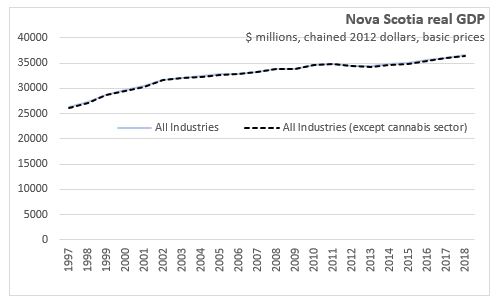

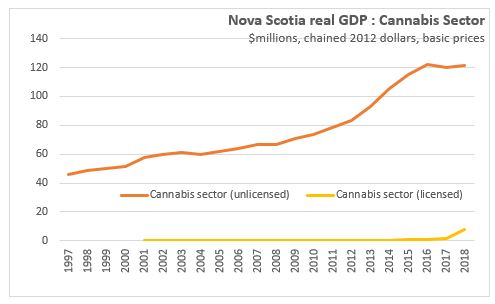
Source: Statistics Canada. Table 36-10-0402-01 Gross domestic product (GDP) at basic prices, by industry, provinces and territories (x 1,000,000)
<--- Return to Archive